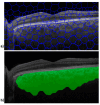A Superpixel-Based Algorithm for Detecting Optical Density Changes in Choroidal Optical Coherence Tomography Images of Diabetic Patients
- PMID: 40573506
- PMCID: PMC12197262
- DOI: 10.3390/s25123619
A Superpixel-Based Algorithm for Detecting Optical Density Changes in Choroidal Optical Coherence Tomography Images of Diabetic Patients
Abstract
Background: This study explored the diagnostic potential of image-processing analysis in optical coherence tomography (OCT) images to detect systemic vascular changes in individuals with systemic diseases.
Methods: Ocular OCT images from two cohorts diabetic patients and healthy control subjects were analyzed. A novel Superpixel Segmentation (SpS) algorithm was used to process these images and extract optical image density information from ocular vascular tissue. The algorithm was applied to isolate the choroid layer for analysis of its optical properties. The procedure was performed by separate examiners, and both inter- and intra-observer repeatability were assessed. Choroidal area (CA) and choroidal optical image density (COID) metrics were used to assess structural changes in the vascular tissue and predict alterations in the choroidal parameters.
Results: A total of 110 diabetic patient eye images and 92 healthy control images were processed. The results showed significant differences in CA and COID between diabetic and healthy eyes, indicating that these parameters could serve as valuable biomarkers for early vascular damage.
Conclusions: The use of the SpS algorithm on OCT B-scan images allows for the identification of new parameters linked to ocular vascular damage. These findings suggest that digital image-processing techniques can reveal differences in vascular tissue, offering potential new indicators of pathology.
Keywords: OCT; algorithm; diabetic; optical density.
Conflict of interest statement
The authors declare no conflicts of interest.
Figures


Similar articles
-
Optical coherence tomography (OCT) for detection of macular oedema in patients with diabetic retinopathy.Cochrane Database Syst Rev. 2011 Jul 6;(7):CD008081. doi: 10.1002/14651858.CD008081.pub2. Cochrane Database Syst Rev. 2011. Update in: Cochrane Database Syst Rev. 2015 Jan 07;1:CD008081. doi: 10.1002/14651858.CD008081.pub3. PMID: 21735421 Updated.
-
Evaluation of Choroidal Thickness in Type 2 Diabetes Using Spectral-Domain Optical Coherence Tomography.Rom J Ophthalmol. 2025 Apr-Jun;69(2):169-174. doi: 10.22336/rjo.2025.28. Rom J Ophthalmol. 2025. PMID: 40698112 Free PMC article.
-
Artificial intelligence for detecting keratoconus.Cochrane Database Syst Rev. 2023 Nov 15;11(11):CD014911. doi: 10.1002/14651858.CD014911.pub2. Cochrane Database Syst Rev. 2023. PMID: 37965960 Free PMC article.
-
Aflibercept for neovascular age-related macular degeneration.Cochrane Database Syst Rev. 2016 Feb 8;2(2):CD011346. doi: 10.1002/14651858.CD011346.pub2. Cochrane Database Syst Rev. 2016. PMID: 26857947 Free PMC article.
-
Three-dimensional choroidal changes in diabetes and diabetic retinopathy: An ultrawide-field swept-source optical coherence tomography angiography study.Microvasc Res. 2025 Sep;161:104832. doi: 10.1016/j.mvr.2025.104832. Epub 2025 Jun 20. Microvasc Res. 2025. PMID: 40545190
References
-
- De Clerck E.E.B., Schouten J.S.A.G., Berendschot T.T.J.M., Goezinne F., Dagnelie P.C., Schaper N.C., Schram M.T., Stehouwer C.D.A., Webers C.A.B. Macular thinning in prediabetes or type 2 diabetes without diabetic retinopathy: The Maastricht Study. Acta Ophthalmol. 2018;96:174–182. doi: 10.1111/aos.13570. - DOI - PubMed
MeSH terms
Grants and funding
LinkOut - more resources
Full Text Sources
Medical

